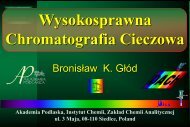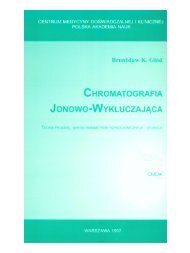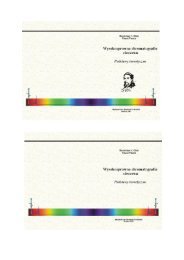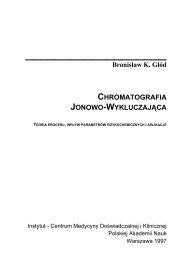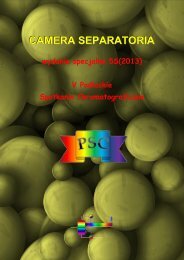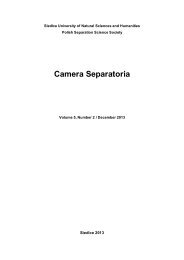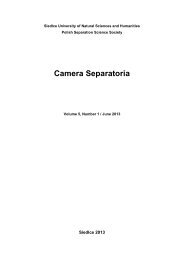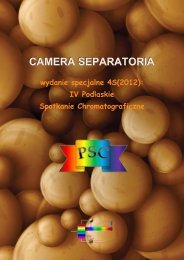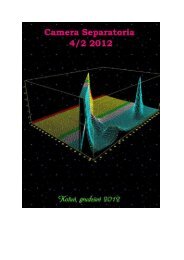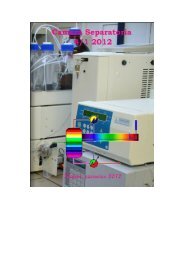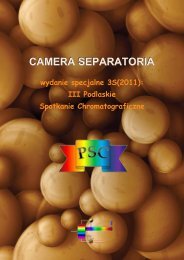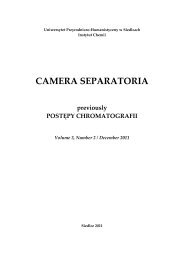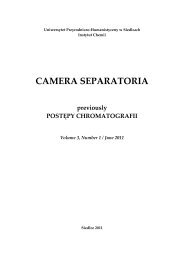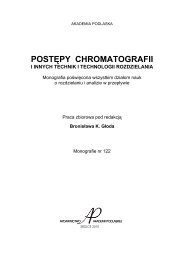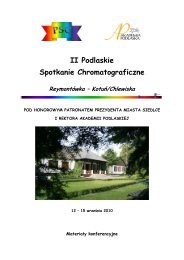CamSep 7 1
You also want an ePaper? Increase the reach of your titles
YUMPU automatically turns print PDFs into web optimized ePapers that Google loves.
66<br />
stacjonarnych typu C18 oraz bezwodnych eluentów o różnej polarności, a także do badania wykluczania i<br />
słabej adsorpcji w warunkach hydrofobowych (lipofilowych) (GPC-SEC-RP);<br />
- Technika TLC-FID, oddaje nieocenione usługi w rozdzielaniu grupowym oraz ocenie składu grupowego<br />
tłuszczów i produktów ich konwersji. Podobnie jak w badaniach tego typu innych nielotnych, albo bardzo<br />
nisko-lotnych skomplikowanych mieszanin związków chemicznych [58–62];<br />
- Natomiast, wykorzystywanie techniki TLC-FID w badaniach "pilotowych" nad doborem korzystnych<br />
warunków wykorzystania wysokosprawnej, kolumnowej chromatografii cieczowej w warunkach<br />
jednoczesnego wykluczania oraz kontrolowanej adsorpcji w normalnych układach faz (GPC-SEC-NP), nie<br />
wydaje się celowe, tak ze względu, tak na stosunkowo wysokie koszty stosowania, jak i względnie dużą<br />
praco- i czasochłonność wykonania badań;<br />
- Odległym, jednakże – jak się wydaje – coraz bardziej realnym celem opisywanych badań, jest opracowanie<br />
optymalnych warunków stosowania kolumnowej wysokosprawnej elucyjnej chromatografii cieczowej (HPLC /<br />
UPC) w trybie wielokolumnowym (NC) i wielowymiarowym (nD) oraz w sposób zautomatyzowany, w<br />
rozdzielaniu, identyfikacji, oznaczaniu, a także otrzymywaniu w skali semi-preparatywnej lub preparatywnej,<br />
wysokiej czystości składników tłuszczów i ich pochodnych – jako grup składników, albo, indywiduów<br />
chemicznych.<br />
Conclusions<br />
Conditions for group separation of chemical standards, representing main constituents of fats and<br />
products of their conversion, as well as, multi -component samples obtained from different stages of fats<br />
processing, were selected basing on literature data and conducted studies. During studies normal-phase thin<br />
layer chromatography (with silica gel as stationary phase) – „NP-TLC-F 254 ” i „NP-HPTLC-F 254 ”, and NP-TLC-<br />
FID technique utilizing Chromarod SIII rods were used. Studies and research were also concerning thin layer<br />
chromatography with n-octadecyl-siloxane (C18) as the stationary phase – aluminum plates "RP-TLC-F 254 "<br />
and "RP-HPTLC-F 254 ", covered with C18 stationary phase. Isocratic elution conditions were used in one- or<br />
several steps mode, with one- or two- component mobile phases having different compositions, adapted to<br />
the purpose of separation.<br />
Based on the results of literature studies and conducted research utilizing GPC-SEC-NP or GPC-SEC-<br />
RP, the following conclusions which are valid not only for fats and products of their conversion, but also for<br />
separation of many other complex mixtures, can be drawn:<br />
- It is highly advantageous to use TLC technique in "pilot" studies performed to select favorable conditions for<br />
high performance liquid column chromatography, in typical adsorption mod e, as well as during simultaneous<br />
exclusion and controlled polar adsorption in normal phase systems, ie., GPC SEC-NP conditions;<br />
- It is also advisable to use thin-layer chromatography with a non-polar, hydrophobic stationary phase, type<br />
C18, and organic anhydrous mobile phases of different polarity to determine the optimum conditions for the<br />
separation of fats and products and to examine exclusion and poor adsorption in hydrophobic (lipophilic)<br />
conditions (GPC-SEC-RP);<br />
- TLC-FID is an inestimable technique in group separation and group composition analysis of fats and<br />
products of their conversion. TLC-FID is also very useful in other studies of this type, concerning non-volatile<br />
or low-volatile very complex mixtures of chemical compounds [58-62];<br />
- On the other hand, the usage of TLC-FID technique in "pilot" studies applied to selection of favorable<br />
separation conditions for high performance liquid column chromatography under simultaneous exclusion and<br />
controlled adsorption in normal phase (GPC-SEC-NP), does not seem to be appropriate, because this<br />
technique is relatively time-consuming, quite expensive in use, as well as, labour-consuming;<br />
- A distant, but - as it seems - more and more real aim of this research is to develop optimal conditions for<br />
high performance elution chromatography (HPLC/UPC) in a multi-column (NC), multidiemsional (ND), and<br />
automated manner, for separation, identification and determination, as well as, production of fats and<br />
products of their conversion in semi-preparative or preparative scale, as pure chemical compounds or<br />
groups of compounds.<br />
Podziękowania<br />
Acknowledgements<br />
Prace były finansowane przez Narodowe Centrum Nauki numer rejestracyjny projektu badawczego:<br />
N N312 417237, numer umowy: 4172/B/P01/2009/37, pt. "Wykorzystanie chromatografii wykluczania<br />
i adsorpcji do rozdzielania i oznaczania grupowego lipidów i produktów konwersji w tłuszczach jadalnych" .<br />
Vol. 7, No 1/2015<br />
Camera Separatoria




